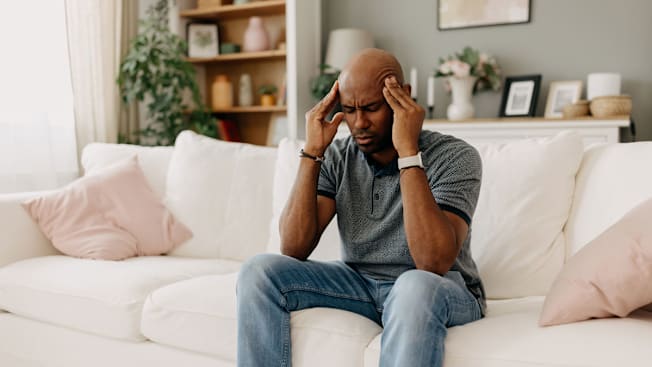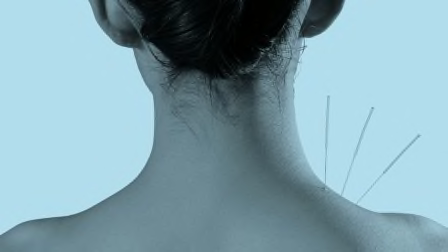What to Do If Your Head Really Hurts
The most effective meds, relaxation techniques, and more. Plus: Special tips for older adults with headaches.

When a headache strikes, you may automatically reach for a drugstore painkiller, like the nonsteroidal anti-inflammatory drugs ibuprofen (Advil and generic) and naproxen (Aleve and generic).
But “some medications we’d normally use, like over-the-counter pain relievers or prescription drugs such as triptans [for migraine] aren’t always safe for people over 50,” says Alan Rapoport, MD, a clinical professor of neurology at the University of California, Los Angeles.
- Headache types: Tension-Type Migraine Cervicogenic
- When a Headache Is an Emergency
Tension-Type Headache
Signs and symptoms: These can occur on their own or when the jaw, neck, and scalp muscles tense up, sometimes in response to stress. “The pain often feels like a band squeezing the head,” says Naveen George, DO, a headache specialist at Case Western Reserve University School of Medicine in Cleveland. Sleep problems and mood issues can increase their frequency.
Prevention: Sufficient sleep, regular meals, and exercise can help keep these at bay, says Vanessa Cooper, MD, a neurologist at Yale New Haven Hospital. Include strength training. A 2023 study published in Frontiers in Neurology found that people who did 12 weeks of neck and shoulder muscle strengthening reported shorter, less severe tension-type headaches. Cooper also advises limiting daily caffeine to two cups of coffee.
Treatment: Step away from activities that may worsen pain, like computer work. A hot water bottle or hot shower can help, too. “The heat will relieve tense neck and shoulder muscles,” Estemalik says. You can also do deep breathing exercises and gentle neck stretches, and massage your temples, scalp, neck, or shoulders. If you need more relief, OTC NSAIDs may be more effective than acetaminophen (Tylenol and generic), but your doctor may advise against NSAIDs if you have heart or kidney disease. “And taking them more than twice a week raises the chance of medication overuse headache,” Estemalik says. If these headaches happen frequently, biofeedback—where you’re taught to become aware of muscle tension and how to ease it—may be useful, Rapoport says. More than 10 headaches a month? Consider asking your doctor about further evaluation and a preventive medication like an antidepressant.
Migraine
Signs and symptoms: About 10 percent of older adults regularly have the throbbing, pulsing pain of migraine, which can last for hours or days. Pain is usually only on one side of the head, but older adults more frequently have it on both, “which may lead them and their doctor to think they may have a tension-type headache,” says Chantel Strachan, MD, a headache specialist and internist at Columbia University Irving Medical Center in New York City. Older adults are also more likely to have eye tearing and a runny nose.
Prevention: Follow a consistent eating and sleep schedule, keep a headache diary to help pinpoint triggers to avoid, and get regular exercise. Shae Datta, MD, a neurologist at NYU Langone Health in New York City, recommends six small meals a day, with a good balance of protein, fiber, and healthy fats. Your doctor may also suggest a supplement such as magnesium. Not enough? Beta-blockers like propranolol (Inderal and others), antidepressants like amitriptyline (Elavil and others), and antiseizure drugs like topiramate (Topamax and others) may ward off migraines. People with more than 15 monthly migraines may benefit from botulinum toxin (Botox) injections.
Treatment: The American Migraine Foundation suggests dimming the lights and applying cold compresses to your temples and the back of your neck. Massaging your neck may relieve tension and stress, which can exacerbate pain. For mild migraines less than four times a month, an OTC pain reliever or NSAID may be enough—with your doctor’s okay, Rapoport says. If not, triptans such as sumatriptan (Imitrex and generic), naratriptan (Amerge and generic), and rizatriptan (Maxalt and generic) may be effective. But these aren’t advised if you have cardiovascular disease because they may constrict blood vessels in the heart, according to Rapoport. In that case, options include:
At-home electrical stimulation devices like Cefaly or Nerivio, which can treat and prevent migraine: “Some stimulate specific nerves, such as the trigeminal nerve—which connects to the brain stem, where migraine pain starts,” Rapoport says. Others kick-start the body’s pain-relieving systems.
CGRP antagonists: Medications such as ubrogepant (Ubrelvy and generic), rimegepant (Nurtec and generic), and zavegepant (Zavzpret and generic) block CGRP, a neurotransmitter that can worsen a migraine.
Cervicogenic Headache
Signs and symptoms: One meaning for cervical is “related to the neck,” and cervicogenic pain is referred from the neck and felt in the head. These headaches, which can also limit your neck’s range of motion, can last for hours or days. They’re often caused by osteoarthritis in your upper spine and neck, George says. OA can make the nerves at the top of your spine more susceptible to pain.
Prevention: Keeping your neck muscles strong and flexible can help prevent and treat cervicogenic headaches. The goal is to build up the musculature around the neck area “to help slow the cartilage breakdown that’s causing your symptoms,” George says. If you need help determining the right exercises, a physical therapist can help. Practice good posture too. When sitting, keep your back and neck straight. “You don’t want to sit for periods slouched forward.”
Treatment: A physical therapy program is the first-line treatment over the long haul. But therapies like short-term use of NSAIDs, an injection of lidocaine into a nerve on the back of your head, and prescription drugs like gabapentin (Gralise or generic), pregabalin (Lyrica and generic) and some antidepressants may ease pain.
When a Headache Is an Emergency
Once in a while, a headache can indicate a potentially life-threatening condition.
How to know when you need to act fast? Go to an emergency room if you experience a sudden, severe headache, especially if you don’t usually have them, Rapoport says.
You should also head for an ER if you have a headache of any severity and one or more of the following:
- Weakness or numbness on one side of your body.
- Sudden vision loss or double vision.
- Stiff neck with vomiting.
- High fever.
ER doctors will want to rule out or diagnose and treat conditions like brain bleeding, stroke, meningitis, and giant cell arteritis—an inflammation of the lining of arteries (especially in your temples).
Editor’s Note: This article also appeared in the July 2024 issue of Consumer Reports on Health.




















